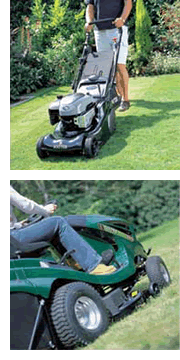Mowing
Lots of people find cutting the grass one of the worst jobs, perhaps because it seems to need doing so regularly in the Summer. Often, because it seems such a chore, it is allowed to grow a bit too long. But this makes the next cut more difficult and time consuming, adding to the "chore factor". However, a lawn which is cut on a regular basis is a pleasure to look at and, if cut at least once a week, it is not such a difficult task.
 Choose what type of mower you want to use. Cylinder mowers for fine / ornamental lawns or a rotary mower for hard wearing / uneven type lawns.
Choose what type of mower you want to use. Cylinder mowers for fine / ornamental lawns or a rotary mower for hard wearing / uneven type lawns.
Don't put off cutting your lawn. During the summer it will keep growing and, within a week, will be a lot longer. The delay in cutting will mean it will take you a lot longer to cut when you do get round to it. The grass box will fill up more quickly which means more trips to empty it.
If you have no grass box on your mower, there will be a lot more grass cuttings left on the lawn. The grass below the cuttings can turn yellow.
Cut your grass when it is dry, as the mower will soon clog up if the grass is wet.
Try and cut your lawn at least once a week. When the grass is growing very quickly in the summer try and cut twice a week. If you cut it regularly, it is quick and easy to do, and will look good most of the time.
Collect grass cuttings it possible.
It is usual to start cutting lawns in March and finish in October. However, in mild winters, a lawn can require a cut during November and even December.
Don't scalp your lawn.
Check the surface of the lawn before cutting, for stones, pet droppings, toys, sticks of wood and branches, wire and string. Remove them as they can damage your mower.
Do not let your lawn get too long or cut it too short. Cut to about 20mm and don't let it get longer than 30mm.
If your mower has a rear roller you will probably be able to put light and dark stripes in your lawn. For a really lovely finish, stripe the lawn first side to side, then up and down, giving a lined effect in all four directions.
Notes:
See mower manufacturers' instruction book for details and always follow the safety instructions.